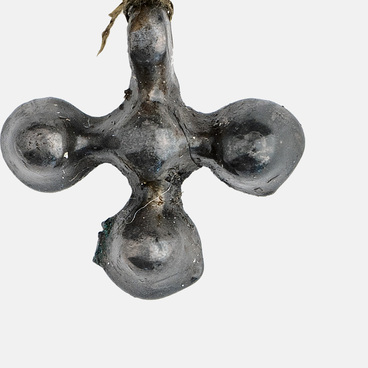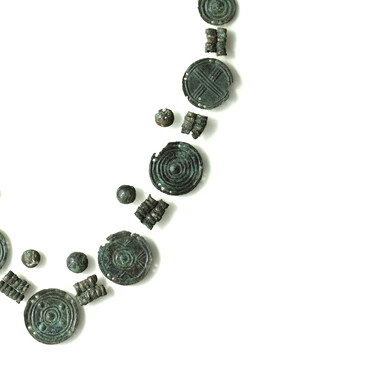In 2003, during the archaeological excavations of the Stepnoye VII burial ground (Stepnoye village, Chelyabinsk region), a plait ornament was discovered among numerous artifacts. The women’s plait ornament was found in grave pit No. 17. A triple burial was discovered in the pit, the remains of two deceased imitated the so-called “embrace pose” with the buried persons facing each other. The remains of the plait ornament were placed behind the back of one of the buried persons. The gender of the buried person is not quite clear. According to anthropological data, the deceased is identified as a woman or a “female-like youth” of 15–17 years of age. All parts of the plait ornament were taken, cleaned and restored in laboratory conditions. The upper part of the ornament, connecting it with the headdress, was destroyed by a robber’s escape. Its fragments (a string of bronze beads and a plaque) were on the ceiling of the burial chamber. The lower part of the reconstructed piece is 32 centimeters long.
The plait ornament consists of six “ribbons”, with each of them ending at the bottom with a leaf-shaped pendant. Three main components can be distinguished in the structure of the plait ornament from the Stepnoye VII burial ground: a) the organic base of a complex composition (leather or fur, it remains unclear), which covered the plait completely, in the form of a rather narrow vertically placed ribbon; b) the supporting base of the plait ornament made of leather strap-belts, located on top and fastened to the organic base; c) the set of ornaments made of bronze and paste, fixed on the supporting base. Three pendants made of wolf fangs were additionally included in the ensemble.
The presence of pendants made of predator’s fangs and shells is characteristic of a number of Bronze Age plait ornaments; it is assumed that they had the functions of amulets and charms. The functional interpretation of such items of the Bronze Age is quite clear due to numerous ethnographic analogies. Moreover, the grave, rich in ceramics (eight vessels) and other funerary equipment, including two bronze axes, belongs to the Petrovo archaeological culture.

